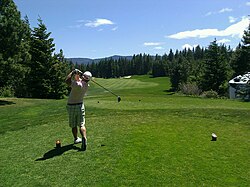
Back Gholf Afrikaans Golf (Sport) ALS ጎልፍ Amharic Golf AN Golf ANG غولف Arabic ڭولف ARY جولف ARZ Golf AST Qolf Azerbaijani
 A golfer in the finishing position after hitting a tee shot | |
| Highest governing body | The R&A USGA IGF |
|---|---|
| First played | 15th century, Scotland |
| Characteristics | |
| Contact | No |
| Type | Outdoor |
| Equipment | Ball, clubs, tee |
| Glossary | Glossary of golf |
| Presence | |
| Olympic | 1900, 1904, since 2016,[1][2] |
Golf is a club-and-ball sport in which players use various clubs to hit a ball into a series of holes on a course in as few strokes as possible.
Golf, unlike most ball games, cannot and does not use a standardized playing area, and coping with the varied terrains encountered on different courses is a key part of the game. Courses typically have either 9 or 18 holes, regions of terrain that each contain a cup, the hole that receives the ball. Each hole on a course has a teeing ground for the hole's first stroke, and a putting green containing the cup. There are several standard forms of terrain between the tee and the green, such as the fairway, rough (tall grass), and various hazards that may be water, rocks, or sand-filled bunkers. Each hole on a course is unique in its specific layout. Many golf courses are designed to resemble their native landscape, such as along a sea coast (where the course is called a links), within a forest, among rolling hills, or part of a desert.
Golf is played for the lowest number of strokes by an individual, known as stroke play, or the lowest score on the most individual holes in a complete round by an individual or team, known as match play. Stroke play is the most commonly seen format at all levels, especially at the elite level.
The modern game of golf originated in 15th century Scotland. The 18-hole round was created at the Old Course at St Andrews in 1764. Golf's first major, and the world's oldest golf tournament, is The Open Championship, also known as The Open, which was first played in 1860 at the Prestwick Golf Club in Ayrshire, Scotland. This is one of the four major championships in men's professional golf, the other three being played in the United States: The Masters, the U.S. Open, and the PGA Championship.
- ^ "Olympic sports of the past". Olympic Movement. Archived from the original on 18 December 2008. Retrieved 29 March 2009.
- ^ Associated Press file (9 October 2009). "Golf, rugby make Olympic roster for 2016, 2020". cleveland.com. Archived from the original on 27 May 2010. Retrieved 23 September 2010.